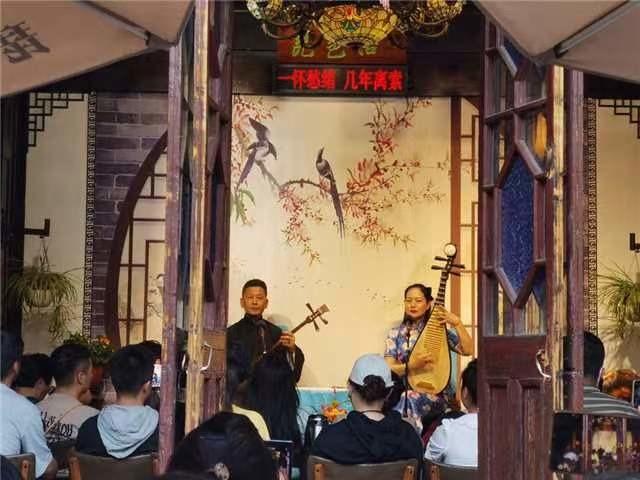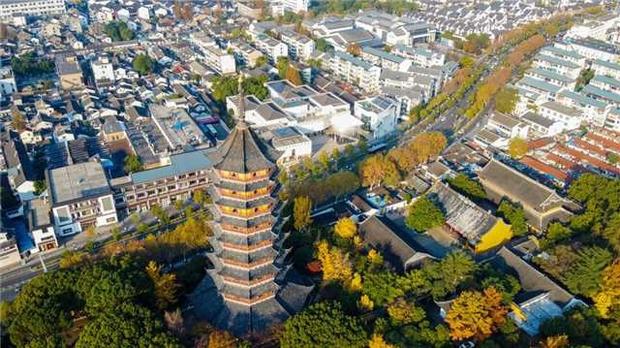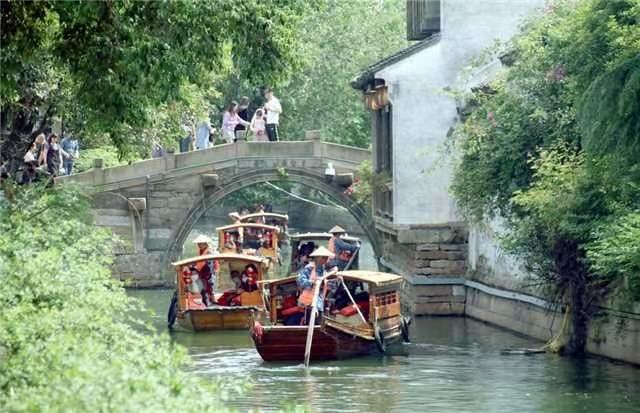 Tourists watch a pingtan performance at a teahouse on Pingjiang Road run by Wu Liangying (right). (WANG KAIHAO / CHINA DAILY)
Tourists watch a pingtan performance at a teahouse on Pingjiang Road run by Wu Liangying (right). (WANG KAIHAO / CHINA DAILY)
For centuries, canals and rivers have flowed past ancient houses in Suzhou, Jiangsu province. The white-walled homes are clad with black tiles dotted with moss.
Under the eaves of properties in narrow, neat alleyways, locals chat in the soft Wu dialect, which can be difficult for travelers from outside the area to understand.
The city of 10 million people, which is a major tourist draw, has taken vast strides in recent years, with a booming modern manufacturing sector established in newly developed industrial zones.
Impressive progress has been made, but the sixth-largest city-level economy on the Chinese mainland also boasts a proud history that has been meticulously protected by locals.
Construction in the city began more than 2,500 years ago when a Wu vassal state was established during the Spring and Autumn Period (770-476 BC).
Gusu district in the heart of Suzhou is home to the city's rich cultural legacy-best exemplified by its classical gardens, which are a UNESCO World Heritage site.
Nearly 1 million people live in the district, including Xu Gangyi, 70, a retired civil servant, who since the early 1990s has regularly walked around the city's ancient neighborhood in his spare time, taking photos to record people's lives.
"A city cannot grow without urban development, but as demolition work began on some of the old buildings, I felt that something may be lost forever," he said.
Xu has photographed alleyways, wells and buildings before they disappeared in demolition work to make way for road widening projects.
The 14.8-square-kilometer ancient city core area is surrounded by moats, and Xu grew up near Panmen Gate, which traverses one of these waterways.
Xu, who has a deep regard for the history of his hometown, has often written letters to the authorities appealing for ancient sites to be spared from demolition.
"Everything we have now was left by our ancestors. What will we leave for our children? Our roots lie in this ancient city, and it has influenced our characters. We'd better take good care of it," he said.
He did not have to wait long to receive positive feedback. In 2002, a comprehensive project to restore the ancient city area was launched by the local government. A series of renovation projects have followed.
During the 1990s, a construction rule was rigidly enforced. This is still the case today. No new building in the ancient city area can be higher than 24 meters-one-third the height of Beisita, a landmark Southern Song Dynasty (1127-1279) pagoda in downtown Suzhou.
Thanks to the rule, no skyscraper breaks the skyline in the ancient city.
In 2018, a provincial-level regulation covering the ancient city area was implemented to rigidly supervise construction. The rule, in particular, stressed that basic colors used in the area should be black, white and gray to "reflect simple but elegant aesthetics". Traditional building materials and styles were also called for.
"I believe that the ancient city will never be destroyed," said Xu, also a former local political adviser. "The area remains as it was, lacking a flamboyant appearance."
ALSO READ: Artist celebrates stars with Suzhou embroidery
 A bird's-eye view of the Beisita pagoda in Suzhou, Jiangsu province. (PHOTO PROVIDED TO CHINA DAILY)
A bird's-eye view of the Beisita pagoda in Suzhou, Jiangsu province. (PHOTO PROVIDED TO CHINA DAILY)
Community rebirth
In September, Suzhou was listed by the National Cultural Heritage Administration as one of six national-level exemplary areas for the protection and use of cultural relics.
In late March, the city government released a new plan for further conserving the old city, focusing on the area within the moats.
Huang Aijun, the Party chief of Gusu, said: "We will continue our efforts to comprehensively and dynamically protect our heritage. Conserving the area's history will be combined with urban construction."
Renovation work on the main ancient neighborhoods will be completed within three years, Huang said, and more projects will follow to better protect the former residences of notable figures from the past and to promote landmark sites.
Suzhou, a major hub for writers and academics in ancient times, once contributed a long list of notable officials through the national exam system.
Pan Shi'en (1770-1854) was a prime example. Standing out for his academic performance, and gradually becoming one of the country's top officials, Pan served four emperors during the Qing Dynasty (1644-1911).
Renovated in 2013, one of his former residences was turned into a museum for zhuangyuan-candidates who took top place in annual national-level recruitment exams for officials.
The site, which boasts a wealth of cultural relics, is not only dedicated to Pan, but to a group of successful figures like him who reached their ultimate goal in life-to serve the country. In ancient China, 50 people from Suzhou gained the title of zhuangyuan, the most among all cities in the country.
The Suzhou government's new plan will see the museum function as a venue to promote zhuangyuan-related culture. Renovation work will also be carried out on the residences of others who excelled in the exam.
Zhou Liping, an official from Pingjiang subdistrict, who is in charge of cultural development and revitalizing ancient neighborhoods, said such work involves far more than turning old buildings into showcases for history.
"The buildings are alive only if they are given new roles. Their exteriors should remain intact, but the interiors have to be adapted to the needs of modern life, like hotels, bookstores and cafes," Zhou said.
It's wrong to just relocate locals and let shopkeepers from elsewhere run businesses here. Native residents play a key role in boosting their home community.
Zhou Liping, an official from Pingjiang subdistrict of Suzhou's Gusu district
Pingjiang Road, an ancient area centered along a 1.6-km-long main lane, boasts a long history, typified by its architecture.
The area has become one of Suzhou's main tourism attractions in recent years, but visitors strolling its streets are probably unaware of the efforts being made to restore some of its past glory.
Before restoration work on Pingjiang Road began in the 2000s, the area was full of dilapidated houses, Zhou said.
Although refined artistic taste is included in the refurbishment plan, as much historical detail as possible has been retained.
For example, in turning a butcher's shop into a club for kunqu (the oldest surviving form of Chinese folk opera, which originates in Suzhou), the planks in the front door were retained. The planks were used to secure the door when the shop was closed.
Bars, karaoke lounges and booths selling street food have become widespread in many revitalized ancient streets in China, but Pingjiang Road is an exception, having little room for them.
"It's wrong to just relocate locals and let shopkeepers from elsewhere run businesses here," Zhou said. "Native residents play a key role in boosting their home community."
Wu Liangying grew up on Pingjiang Road. Once an established performer of pingtan-an indigenous type of singing from Suzhou-Wu, who is in her 50s, chose to return to her home neighborhood from elsewhere in the city in 2017.
She opened a teahouse in a renovated villa built in the 1920s, where she holds daily afternoon pingtan performances. Tickets for a show, which include a cup of tea, cost 38 yuan (US$5.90).
"There are plenty of opportunities to seek a new career in other cities, but like many others, I choose to stay (in Suzhou). Life here is comfortable and we cherish the psychological support given by this area and its culture," she said
Wu, who has uploaded clips of her performances in the teahouse to the Douyin short-video platform, where she has more than 110,000 followers, understands that new methods have to be adopted to promote Suzhou's traditional culture.
 Tourists enjoy cruising on a canal near Pingjiang Road, an ancient area centered on a 1.6-km-long lane that boasts a long history. (WANG JIANKANG / FOR CHINA DAILY)
Tourists enjoy cruising on a canal near Pingjiang Road, an ancient area centered on a 1.6-km-long lane that boasts a long history. (WANG JIANKANG / FOR CHINA DAILY)
Ideas benefit natives
In revitalizing old neighborhoods, Suzhou faces a problem common to many cities. As unfashionable industries are moved out of the ancient area to protect cultural heritage, and old homes fall victim to rapid urban development, how can local people be encouraged to remain?
Shan Jixiang, an urban planner and former director of the Palace Museum in Beijing, said: "It's like an ecosystem. If local people cannot enjoy the benefits of living comfortably through the renovation of the old cities, governments will feel that the cost of protecting cultural heritage is a burden and that the ecosystem is not sustainable.
"Tourism is important, but only when it is combined with improved facilities in local people's everyday lives."
Some recent renovation efforts in Suzhou have set an example though.
In 2019, the television reality show Dream Home inspired designers to renovate a market near Pingjiang Road, which used to mainly sell vegetables. Within a few months, the show had become an online hit.
After the renovation, Shuangta Market features exquisite and fashionable decorations, shops selling creative souvenirs, together with a bookstore and cafes. The market is equipped with a big data analysis system to accurately trace the origins of every vegetable sold and to ensure the venue runs like a factory.
Liu Yunlong, a manager at the site, said some people doubted whether a vegetable market should undergo such an elaborate transformation. However, by redefining a market in the ancient city, he said more possibilities have been created and the venue has proved popular.
About 8,000 people visit the market on a weekday, and the number rises as high as 12,000 on weekends. All the 60 or so original shopkeepers and vendors remained at the venue after the renovation.
"Shuangta Market attracts customers from a much wider community. It is now more dynamic and also serves as a reference point for running a market in a more scientific way," Liu said.
Similar improvement projects have been carried out at five other markets in the ancient city area.
Bian Xuefang, 49, who has run a tailor's shop at Shuangta Market since 1998, said many new customers have started to visit the venue.
"Thanks to the renovation, many tourists order qipao (the traditional Chinese women's dress) in my shop," she said. "When they go back to their home cities, they recommend the shop to many more customers. I'm getting much busier, and being busy is great."
Despite the booming e-commerce sector, Bian has no plans to open an online store.
"I like to treat whoever comes to my store in the way I did my old neighbors. No matter how times change, I prefer face-to-face communication. It's also essential that my products are of good quality," he said.
Life is slower in the ancient city area, where an area for locals to sit and read quietly is vital, rather than them staring at digital devices.
Zhaoqing Temple, near Pingjiang Road, was built during the Yuan Dynasty (1271-1368), but later abandoned. It was used as a primary school from the 1950s to the 1980s, but saving the fading architecture became a problem after the school moved.
Shi Zheng, director of the Gusu district cultural gallery, explained the idea to renovate the site and turn it into a community cultural center.
"People today may find it difficult to search for some old but precious files on local culture in public libraries, but the center is a perfect place for them," Shi said.
A large collection of books on the Wu dialect, history and culture are housed in the cultural center library, which loaned more than 30,000 books to local residents last year, Shi said.
Exhibitions and lectures on intangible cultural heritage and other folk art in Gusu are also held regularly at the center to help people remember the past and better know their hometown.
"For retired senior citizens, this institution is essential. It's also great to see other local residents spending some time in the library after they finish work," Shi said.
To attract more young people, performances of xiangsheng, the comic dialogue also known as crosstalk, are organized every Saturday night, offering a new tourist attraction for the community.
The cultural center needs to be well-connected to the rest of the city, as Shi said it functions as one of 96 branches of the Suzhou Library. Readers can borrow books from the center and return them to any other library, and vice versa.
Wang Yong, a professor of urban planning at Suzhou University of Science and Technology and deputy director of the Suzhou Institute for the Conservation of National Historic Cities, said: "A successfully restored historical neighborhood should be residential, and this has been achieved in Pingjiang. Despite numerous visitors, you'll feel a sense of nature rather than noise."
The Architectural Society of China and Suzhou city government have organized two conference sessions to showcase designers' plans to refurbish ancient architecture, using sites in Suzhou as examples. A third session is due to be held later this year.
However, Wang said it is more important that these examples are used to inspire the public to contribute solutions to the dilemmas facing old communities.
"We still need further exploration to create more working opportunities within ancient cities, including Suzhou, to maintain their vitality and boost the economy," she said.
"Improving transportation without affecting historical heritage is another problem that urgently needs to be overcome."
READ MORE: Suzhou FTZ fuels tech innovation
Zhou Furong and Lu Yujun contributed to this story.
Contact the writer at wangkaihao@chinadaily.com.cn


